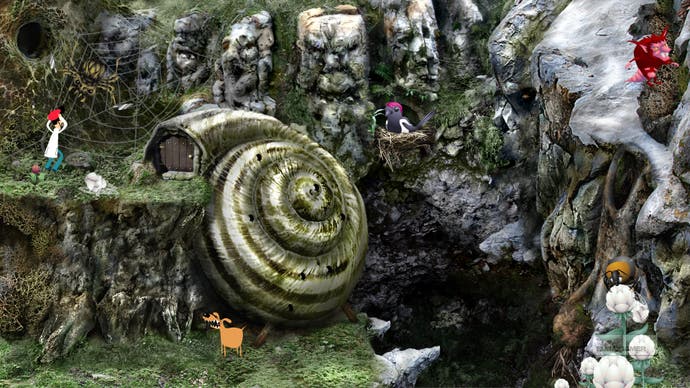Axel & Pixel
More of the Samorost?
These mini-games are inserted into the ponderous game flow to provide action relief from the otherwise pedestrian tasks. At the lowest level, the game employs that most divisive of devices, the quick-time event, and control-pad button prompts flash onto screen as you, for example, scale a wall. Miss or perform an incorrect input and you need to start over.
The QTEs are incongruous to a game that's otherwise rich in metaphors, but it's as if the developer acknowledges their incongruity. In one tense moment, you have to enter a series of prompted button-presses to help Axel leap from pillar to post while being chased by a giant rolling boulder. For a moment, the ambient soundtrack gives way to Indiana Jones timpani, before, the set-piece complete, everything slows once again to its natural ponderous rhythms.
Even so, acknowledging that a reaction-based QTE sits awkwardly with the rest of your game doesn't excuse it, and these moments, while implemented to introduce some urgency, add little and threaten much to the overall ambiance.
More structured interstitial mini-games also break up the puzzle-solving. In one you must navigate a hot-air balloon through a network of tunnels, balancing the use of fuel with the balloon's health bar. It's a long sequence with no checkpoints to provide a shifting safety net and the high difficulty merely extends the length of the experience through the use of repetitious restarts, rather than doing anything to deepen it.

More successful are the other meta-game tasks that are a lot more in-keeping with the core game's ideology. Some scenes can be arranged in such a way that they inspire Axel to take out his easel and paintbrush and sketch the vista. With seven sketches to find, each contributing to a lager mural, this collectible is engaging and consistent with the game's premise. Tubes of paint and dog bones an also be found in the environments, with bonus rewards for collecting each set, and these smaller objectives help to break up the otherwise-unflinching goal of moving from left to right through the game.
Axel & Pixel is the sort of game that will infuriate as many as it enthralls. It is, in a sense, a slow-motion celebration of gaming's first principles. You observe, play with the tools on offer in any scene and, click by click, work out the correct sequence of interactions that will lead you to your broader goal. This is all that any videogame asks of its player, and yet, the drawn-out sequencing of these events will bore players who prefer their game lessons to be taught in the whistle of a headshot or the blur of a hairpin corner.
But for those willing to sit back and savour the unhurriedness, the experience can be both enlightening and rewarding, revealing as it does truths about this world even as it paints a vivid picture of another. Axel should be proud: that surely is the highest calling of any artist.
